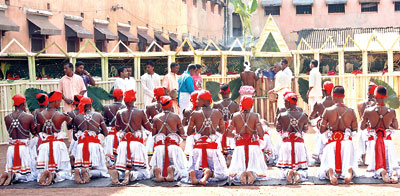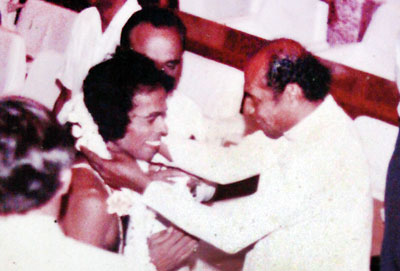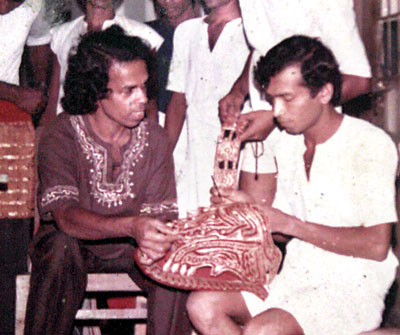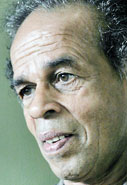A.D. Jinadasa Nivithigala was recently where many would tremble to be, brimming with confidence and happiness. He was the revered Gurunnanse invited to place Ves on many who had reached the relevant expertise to be called Kandyan dancers.
As he walks into these once-familiar surroundings, the memories come flooding in…….long days and nights with everyone else “without” heavily locked and barred doors and he and his students “within”.
Padlocked inside (with a “vishala ibbek”) he was on a strange mission to teach prisoners to dance and dance they did winning the admiration of many at the first-ever performance they put up back in the 1980s.
 |
| Big moment: Inmates ready for the Ves placing ceremony recently.
Pix by M.A. Pushpa Kumara |
Starting just once a week, every Thursday from 2-3 in the afternoon in 1982, the classes evolved into twice weekly and finally daily sessions. Two years he trained them, those condemned as the dregs of society, and when the decision was taken to hold a public performance, the drumming and dancing intensified into the night.
Recalling that it was with trepidation that he walked into K-ward of the Welikada Prison the first time, where he was supposed to train more than 20 prisoners who had committed “eka eka varadi” (various kinds of crime), Nivithigala Gurunnanse, 67, says, “Puduma bayak thibbe.
Tikak kal giyama, huru wuna.” (He was terrified but got used to it after a while.) Among his protégés were many convicted of murder including a man “in” for killing his wife’s paramour. As the public performance drew near, he not only had to train them but also sew the costumes the prisoner-troupe of dancers would wear. “Every evening at 5, the guards take the prisoners out of the ward, search them and send them back in. I too would be in the ward sewing or training them till late,” he says.
Yes, starting with the simpler namaskara harambaya, dolos pa saramba and dolos goda saramba, he also taught them the intricate moves of the daha-ata wannama and shastriya natum such as the kohomba kankariya.
“It was not difficult to train them,” he says, explaining that they were never late for classes or played truant on the pretext of being ill. They would be all smiles as they cherished the fact that he called them by name and not by their assigned number.
The dance classes followed a meeting in February 1982 between the then Commissioner of Prisons, J.P. Delgoda and veteran dancer Pani Bharatha.
 |
| The first show in 1984: Pani Bharatha greets Jinadasa Nivithigala |
 |
| Back in time: Jinadasa Nivithigala and inmates preparing costumes inside the prison for their first show |
The scene of that meeting is engraved in his memory. On one side were the prison officials with the K-ward inmates in their jumpers standing respectfully at the back while on the other was Pani Bharatha and himself. When the suggestion was floated, Pani Bharatha readily agreed, followed by loud clapping from the prisoners. When Pani Bharatha began pondering who the Guruwaraya would be, Nivithigala Gurunnanse felt a compulsion to step in, “for prisoners are human beings too”.
Soon after, the dance lessons began, a good nekatha having been checked out.
For Nivithigala Gurunnanse from the village in Ratnapura with the same name (he explains that when Ves is bestowed, the dancer is identified by the name of his ancestral village), the love of dancing began as a lad of 13. Learning his first hesitant Kandyan dance-steps under Master Weerasena at the Karawita Madhya Maha Vidyalaya, he was fortunate to catch the eye of a philanthropist in the area, Sam Elapatha Bandara, who offered him a six-year scholarship to the Polgahawela Kalayathayana. Here he came under the expert tutelage of Simon Shilpadipathi.
Going back to his village to do “kala katauthu”, he decided to spread his wings by the time he was 22 and came to Colombo. It was then that his path crossed that of Pani Bharatha who invited him to stay in his home at Madinnagoda in Rajagiriya and propelled him into the “kala lokaya”.
Nivithigala Gurunnanse steps back to the time when he shot into fame as Hanuman (the Monkey-King) in Arisen Ahubudu’s ‘Sakvithi Ravana’ production. Auditioning for the role, he had been thrilled when Auhubudu jumped up and embraced him exclaiming, “It is like completing Sakvithi Ravana,” on seeing his performance.
Nivithigala Gurunnanse is also known to many as “Pombule Uncle” being closely associated with the Pombule Geethaya.
Amidst many other achievements, the one closest to his heart, however, is the time he spent with Welikada’s prisoners. Even though the dance lessons ceased in the late 1980s with unrest sweeping through the prisons, he speaks of the many forays into the public view after that first performance, where they would hop on the Black Maria with just two prison officials, mainly Palitha Bandara and Yasawardena.
 |
| The Gurunnanse today |
“Never, ever was there an attempt by a single prisoner to escape,” says Nivithigala Gurunnanse, adding that once when they were to perform at the Ratnapura Town Hall, there was no water and some of the prisoners were sent some distance to get water. “Remember, these prisoners were not manacled and could easily have escaped, but they didn’t.”
It is with pride that he remembers a five-day competition held at the Pelmadulla Raja Maha Viharaya. It was 1988 and the 24-prisoner dance troupe was acclaimed by all the Samaneras as the winners even before the verdict was announced.
But for Nivithigala Gurunnanse, the jewel in the crown is still that first performance, ‘Sipiri Geyin Rangana Rangum’ (‘Dances from Prison’) back in 1984. Many items were on the agenda….Gajagawannama, Pantheru, Gemi Netum, Low and Up-country dances et al with the piece de resistance being the heart-rending story of a fatherless youth who begs his mother’s employer, a stone-quarry owner, for a few rupees to get her some medication as she is very ill. Scorning his pleas, when the quarry-mudalali attempts to chase him away, in a fit of uncontrollable emotion he grabs the heavy hammer with which stones are smashed and fells the mudalali.
The son’s song from prison, lamenting not only his plight but also that of his mother who wanted to make him a raja by slaving at the quarry, dramatized as a dance leaves the audience of that first performance at the BMICH spell-bound and then on their feet with thunderous applause.
Among those offering the standing ovation was the then Justice Minister Nissanka Wijeyeratne who later came backstage and garlanded the prisoners, smiles Nivithigala Gurunnanse whose excitement is mounting once again.
For, he has been invited by Rehabilitation and Prison Reforms Minister Chandrasiri Gajadeera and Commissioner-General of Prisons P.W. Kodippili to revive ‘Sipiri Geyin Rangana Rangum’, of course, with a different set of dancers from Welikada. With the help of prison Superintendent Gamini Jayasinghe, the performance is on the cards for end-February. |





